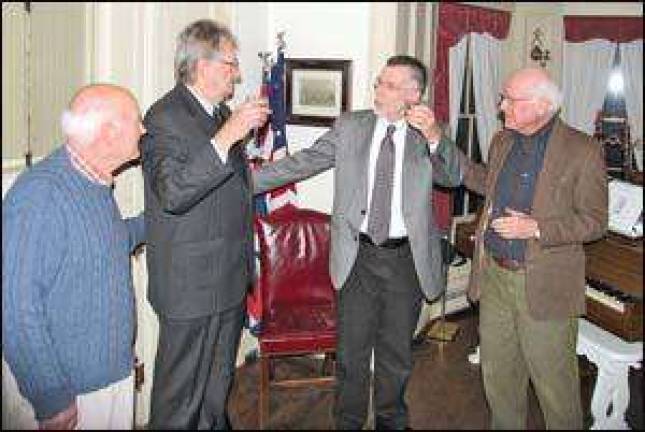Warwick bids farewell to Dave Brandt

Longtime architect’s influence is seen in many public projects, By Roger Gavan WARWICK - The Village of Warwick would not be what it is today without architect Dave Brandt. That was the message every speaker echoed at a farewell reception and award presentation in Brandt’s honor sponsored by the Town of Warwick Historical Society. The well-attended event was held at Baird’s Tavern on Thursday evening, Feb. 24. Brandt, who had served Warwick as an architect since 1968, retired in December. And just two days after the reception, he and his wife, Ana, moved away from Warwick to live in Europe. They own homes in both Orastie, Romania, where Ana was born, and in Northern Tuscany, Italy. Dave Brandt was a past president of the Warwick Valley Chamber of Commerce, a member of the planning board and founder of the Architectural Review Board. Beautification, trees and history He spearheaded the Warwick Beautification Committee and was also instrumental in the organization of the Shade Tree Commission, the establishment of the historic district and the Historical Society’s revolving fund that could be borrowed and used to renovate buildings within that district. As an architect, Brandt designed numerous private homes as well as the Kennedy Medical Building, the municipal parking lots on Spring Street and on South Street, which also incorporated the picturesque Bradford Pear trees, and the original Carriage Path foot bridge. He was the award-winning designer for the renovation of the Demerest House and the historic railroad station on Railroad Avenue. Shaping positive outcomes Before introducing the speakers, the Society’s Executive Director, Jo Hull, recalled hearing that in 1963, the young Brandt visited Warwick for the first time to attend a New Year’s Eve party. “When he left late that night,” she smiled, “he bumped into a tree - walking, not driving of course - and fell to the ground. Lying on his back he looked up at the beautiful star filled sky and decided then and there that Warwick would be his home.” Brandt moved to Warwick in 1965. And one year later submitted his architectural thesis for his master’s degree on a plan for the restoration of the Village and preserving the historical beauty of its buildings. Town of Warwick Historian Dr. Richard Hull explained that in those days, Warwick was much different than it is today. “In the 1950s and early 1960s businesses like Borden’s were closing,” he said. “Buildings were being demolished, the trees along Main Street were dead, Wawayanda Creek was a dumping ground and there was a used car lot across the street. Warwick looked pretty shabby.” 'Thank you’ Hull added that a master plan, at that time, called for garden apartments and the like but Brandt had a different vision. “He showed us we could make Warwick beautiful again,” he said, “as it was pictured in the old post cards.” Other speakers that evening included Town of Warwick Supervisor Michael Sweeton, Mayor Michael Newhard and Pat McConnell, president of the Town of Warwick Historical Society. An amusing incident occurred when Brandt produced a copy of, Think of Warwick, a brochure he had designed to attract businesses and people to Warwick. He showed the audience one page, which had a photograph of a huge crowd of local citizens that had assembled on Main Street for the photographer and added that many of those people were no longer here. “I’m one of those people,” said Dave Hull, owner of Applewood Orchards, who stepped forward to tell numerous anecdotes about those days and the role that Brandt played in shaping positive outcomes. Brandt told the guests that he was overwhelmed with this farewell gesture organized by the Historical Society. “I want to thank all of you,” he said. “You are the community.”
I want to thank all of you. You are the community.” Dave Brandt
In the 1950s and early 1960s businesses like Borden’s were closing. Buildings were being demolished, the trees along Main Street were dead, Wawayanda Creek was a dumping ground and there was a used car lot across the street. Warwick looked pretty shabby. (Dave Brandt) showed us we could make Warwick beautiful again as it was pictured in the old post cards.” Town of Warwick Historian Dr. Richard Hull